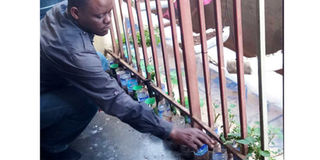Making good use of your outdoor space

Mawanda shows off bottles with beans and amaranthus at his home in Wakalinga. Some landlords have specific rules about what you can and cannot do around their rentals so permission must be sought. Photo by Phionah Nassanga
Gardening can be a great way to productively pass time during this lock down. Jane Nabuuma, a florist at Lungujja, says during this time when everything seems tough and uncertain, you can decide to give your backyard a functional use by planting a vegetable garden.
However, those with no space can decide to make good use of bottles, containers, jerrycans and tyres.
When well-planned, a vegetable garden whether in containers or open garden, enhances the beauty of a home and reduces the cost of vegetables in the home.
“When well-arranged, many vegetable give off attractive and colourful flowers adding beauty to your apartment or rental.”
Vegetables and flowers
To Nabuuma, growing vegetables and flowers together is a great way of maximising space and saving money.
For those with flowers along walkways, at the front or backyard, you can use this opportunity to fill the spaces between the different flowers with the vegetables such as the spring onions. She says when planted along walkways, spring onions look attractive.
“When you grow green [spring] onions in a period of one month, you will be picking off leaves for your salads and soup.”
Michael Ssozi, a landscaper, says when you choose to add vegetables to your flower gardens, consider the overall look of each plant and choose those that complement each other as well as those sharing the same growing requirements as the vegetables you desire to grow.
For instance, some flowers do well under the sun while others prefer the shade. Some are tolerant to drought conditions while others require plenty of water. For better results, he says you need to make sure that when growing vegetables together with flowers, they are positioned in the same beds with those that need the same conditions.
“You can grow a path of cabbage and lettuce together with flowers mixing them with flowers of red, pink or multi-coloured leaves,” he says.
Keep it simple and attractive
Nabuuma says it does not matter whether you are a tenant or not, but how you get creative with the available space will help you reduce your cost of living during this lockdown.
To Ssozi, it is not just a matter of gathering containers, you can still give them an attractive look.
“You can add a little paint to the containers and tyres. This applies mostly to people who are looking at hanging them on the balcony or keeping them on the verandah. You can as well use good looking wrapping paper bags that are aerated,” he adds.
Landlord’s permission
Some landlords have specific rules about what you can and cannot do around their rentals. David Mawanda a resident of Wakaliga in Kampala, says before doing anything, it’s better if you shared your plans with the landlord. Let them know how you want to maximise the space you have to enjoy gardening as much as anyone.
He mentions that if you only have balcony space, do not let it stop you from indulging your horticultural desires.
“My family and I occupy a small space, but I asked my landlord to let me make use of the verandah. I collected water bottles and jerrycans where I decided to grow beans, sukuma wiki, green onions and dodo.”
Mawanda says soon he will be harvesting his dodo (amaranthus). He advises those interested to look out for vegetables that produce a great volume of food. However, to also remember that they should grow vegetables their families enjoy eating.
Vegetables to opt for
Mawanda says during this lock down, your focus should be on growing fast growing vegetables that you can continuously pick any time as long as the tender leaves have shot up.
These include Nakati, dodo, eggplants, Spinach, cabbage and lettuce, sukuma wiki, mushrooms, squash broccoli and spring onions.
“Before the coronavirus pandemic, a small bundle of nakati cost Shs500 but now, the same goes for Shs1, 000,” he says.
Location of containers
Avoid placing containers too low where they can become insignificant against a busy or conflicting background. Vary the levels by placing them on different levels like on benches and stairs.
Hanging containers should be at chest level, so that people can see them. Or should be more than six feet high so that people do not bump into them. Plants at waist level and below should be away from paths and areas where children can interfere with them.
Containers must be well drained. Most have some holes at the bottom for this purpose. For converted ones, you need to drill your own into them.




